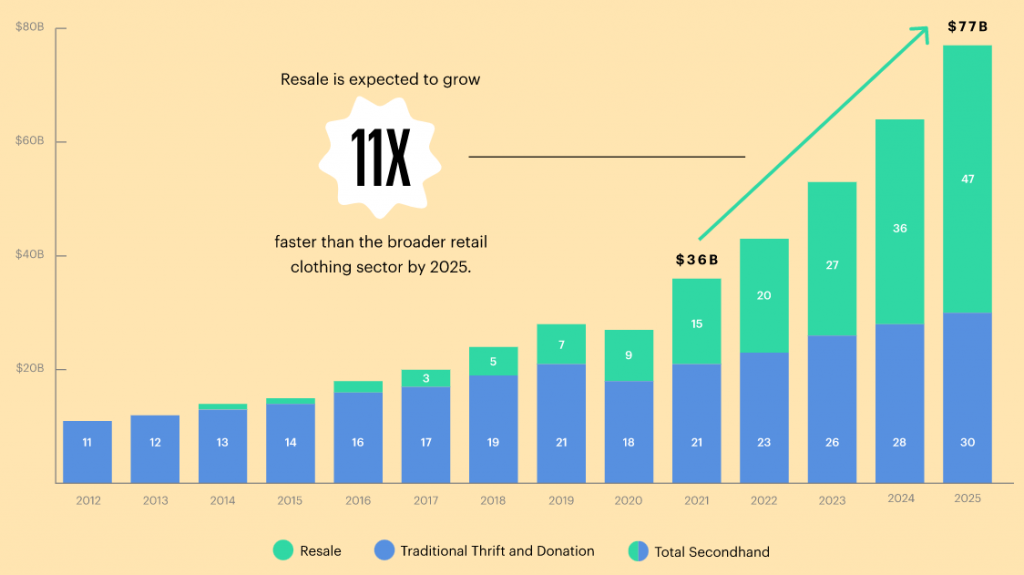As someone who cares deeply about the environment, I have tried to explore how I can buy clothes I love without damaging the world we live in. Just like many people, I have ended up buying my clothes at thrift stores. Thrifting is not only a more sustainable option than fast fashion, but it is also more within the budget of many struggling people. However, it seems that thrifting has recently become a trend on social media, but how did this occur?
Staying trendy on a budget
‘Thrift Haul’, ‘Come thrift with me!’; these are titles you will often see on YouTube. In these videos, YouTubers takes the viewer along with them as they go shipping in thrift stores. From chunky grandpa sweaters to a 90s slip dress, these YouTubers find some of the most beloved clothing items and share them with the world. Nowadays, these types of videos are being published at an exponential rate. But when did this trend start? While thrifting is a vital way of living for low-income families and has been for decades, it has become popular for younger and wealthier generations since the beginning of the 21st century. Thrifting has even become a trend rather than a way of buying clothing on a budget. Sadly, the popularity of thrifting could negatively affect low-income families who rely on it. For example, people of higher incomes that partake in this thrifting trend could potentially rob the low-income families from staying stylish or even warm. The reason for this is because of the popularity of thrifting, the prices in thrift stores has increased due to higher demand. Not only that, but there are also people hording a huge amount of items and selling them at a higher price on resell sites like Depop or ThredUp. The latter is even expecting their resale to increase by eleven times by the year 2025, so it is not a phenomenon that will quickly disappear.

Fast fashion and its problems
With the rise of social media, fashion trends have become more accessible, but they have also risen and disappeared at a faster rate. These so-called ‘microtrends’ are trends created by fast fashion brands that include a specific type of fabric, model or clothing item that has become popular. It is brands like Shein that create these trends, not only by inventing them in a mere couple of days. They also produce them as fast as possible, and of course, as cheap as possible. However, as the name might suggest, these microtrends only last a few months or even weeks. As these microtrends fall out of fashion, they also get discarded out of closets and get dumped in thrift stores. Now, these fast fashion clothing articles are filling thrift stores and will likely stay there, due to their cheap and fragile nature. Luckily, the fast fashion industry is on its path to slow fashion. For example, brands like H&M have created transparency regarding their garment supply chains. Still, fast fashion has a long way to go to become slow fashion, or even be considered intermediate fashion.
Thrifting consciously
At first glance thrifting seems like the sensible solution to ending fast fashion. However, as noted in this blog, thrifting could still be harmful to the planet and its inhabitants. Do not be alarmed, there are still ways you can thrift consciously. First of all, you can reevaluate why you go thrifting in the first place. Do I have a limited budget? Am I thrifting solely for the trend? Am I trying to avoid shopping fast fashion? Secondly, when thrifting try avoiding buying in large amounts and try donating your own clothing once in a while. So while you’re thrifting, try asking yourself these questions so that you may help not only your own budget, but also the environment and its inhabitants.



Great content! I personally really enjoy thrifting for all kinds of stuff. I personally also noticed how well-known brands try to recreate the “thrifted-look”. There are popping up quite some online thrift stores on social media. Accounts that, for example, only sell the classic Ralph Lauren pull-overs. However, sometimes I doubt whether these clothes are realy second-hand or bought new and sold as for high prices as “vintage”
Interesting topic! I have also recently became interested in ways to shop more sustainably, and thrifting has been one of them. However, as a person who is on a smaller side, I find it really hard to find anything in my size. Like you mention, I felt that the increase in popularity of thrifting would really affect the people who are really in need of affordable clothing, as I even felt that the choice was extremely limited. Additionally, I found that in order to buy anything that fits to the whole aesthetic of “vintage look”, you actually have to spend a lot of money on them (sometimes even more than new clothes), and actual thrift stores only hold items from companies like H&M. I have looked into sustainable brands instead, however they tend to be on the expensive side, and it is not affordable for students like myself.
As someone who has been taught how to thrift by my mom from a very early age, I have noticed a rise of “premium” vintage shops as soon as thrifting became more popular. I think that these kinds of shops are for people who want to follow the trend but don’t actually have enough patience to go through piles and piles of clothes to get to this one precious item. They choose to go to a small vintage shop that does this job for them by picking the clothes that fit the current fashion trends and re-sell them for a much much higher price. After reading your post I’ve realized that this practice can limit the fashion options for those who actually benefit from thrift shops. Thank you for this post!
While I do believe that any trend concerning the concept of reusing rather than buying new is a positive one, I also agree with your concerns for how thrifting is being shaped by a high consuming society. I would much rather watch thrift hauls where people found beautiful pieces of clothing for a 100€ instead of people showing their “SHEIN-Hauls” for instance, where they spend several hundred euros on pieces that they will only wear once or twice. I really like that your post gives some guidance to, and comments on the fact that not all thrifting is sustainable, as I also think that anything we buy should be considered in terms of what we need and that we can be way more considerate of the amount of things we buy. The second-hand application Vinted is something I would really recommend, as it lets you sell your own clothing for a reasonable price, and you can also buy from others selling what they have previously loved, or what they do not use anymore. Here it also becomes clear that people have way too many items and society encourages us to get more, instead of finding solutions to recycle our things.